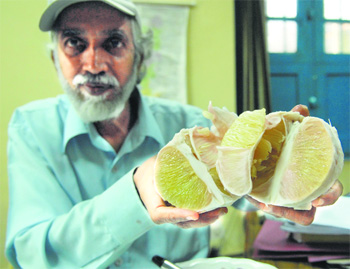http://www.bangaloremirror.com/article/10/2010010320100103130342306c3fdce05/Waiting-for-Lalbagh-Seedless.html
Waiting for Lalbagh Seedless
Niranjan Kaggere
Posted On Sunday, January 03, 2010 at 01:03:42 PM
A victim of the booming realty industry, the tangy chakkota fruit is all set for a resurrection. And taking the lead is Lalbagh, which has successfully cultivated a variety of the fruit which will be christened Lalbagh Seedless
The yearning for good health and vitality is all set to witness a new spin: Chakkota (pomelo), a citrus fruit thats exclusive to the city since the days of the British Raj, is all set for a rebirth.
The fruit, a victim of the realty boom in the northern parts of the city, including the Devanahalli area, was introduced in the early part of the 1800s by the British. But as the city grew, chakkota cultivation witnessed a steady decline. Not wanting namma chakkota to be listed in the extinct category, the department of horticulture embarked on a mission to protect the fruit by obtaining a Geographical Indication tag (GI) for the fruit.
The department, shaken by the considerable fall in the production of citrus fruits, way back in 2000 decided to revive the native fruit rather than embrace other fruit varieties. Over the years, the consumption of citrus fruits in Bangalore has increased considerably. Be it a result of growing health consciousness or an awareness of the nutritious diet concept, the consumption of citrus fruits has increased by 50 to 60 per cent in the last four to five years. However, production of the fruit was gradually declining. This prompted us to come up with a solution to improve the local varieties to augment production and meet the growing demand for the fruit, said a senior horticulture official.
 Dr S V Hittalmani, Additional Director of Horticulture (Fruits)
Dr S V Hittalmani, Additional Director of Horticulture (Fruits)
showing the Lalbagh seedless variety of Chakkota
The department, under the National Horticulture Mission Programme, imported a few varieties of chakkota from Thailand. Around 100 samples were planted in various parts of the state in 2000 to test their adaptability. Close to 25 samples were planted in and around Bangalore including Lalbagh, Hulimavu, Devanahalli, Hesaraghatta and other places. However, it was only in Lalbagh that one of the samples started thriving. Two other places in Karnataka also proved congenial for the fruit, said Dr Hittalmani, additional director of Horticulture (Fruits).
The new variety which is successfully yielding fruits in Lalbagh will be named Lalbagh Seedless and propagated among farmers. By June, we will start grafting the plant and at least 1,000 plants will be distributed among farmers in and around Bangalore in an effort to encourage chakkota cultivation, he said. What is interesting is that the fruit can be grown in ones kitchen garden or backyard. There is another variety which has been developed at Hesarghattas Indian Institute of Horticulture Research (IIHR) and it is called Devanahalli Red. It will also be popularised along with the Lalbagh Seedless.
A health fruit
Chakkota or pomelo is a native of South China and South East Asian countries and belongs to the citrus fruits category. The fruit which is a bigger version of the orange, is known for its therapeutic qualities. The fruit is of great importance for those who are suffering from heart related ailments as it reduces cholesterol and purifies the blood. It is also used as an anti-oxidant and prescribed for people recovering from chikungunya in order to tone their fatigued muscles, says Dr Hittalmani.
From China to Bangalore
The tale of the chakkota is as fascinating as the history of Bangalore. According to records with the Horticulture department, the fruit made its entry into the city along with the Britishers way back in 1880. Although some believe that it was Tippu Sultan who introduced the fruit to Bangalore, there are no substantial records to prove the point. However, according to available records, it was the Britishers who introduced the fruit to Bangalore at a time when they introduced oranges in Kodagu, says Dr S V Hittalmani.
Soon, the cultivation of the fruit was taken up on a large scale in Bangalore. Even though you get to see chakkota trees in Kodagu, they are restricted to only a few patches. But in Karnataka, the fruit took root in Bangalore and acquired the sobriquet Devanahalli chakkota. It was believed that there were around 10,000 trees then. But now, the number of trees has come down to just 400-500, explains Dr Hittalmani.
Mindless development and the booming realty in and around Bangalore, especially around Devanahalli in the last one decade, lead to the destruction of the fruit. In 1990, there were only 1,000 plants remaining. The count further dipped as low as 100. However, in the last few years, it has increased to 400-500, thanks to a few farmers. Across the state, there are about 8,000 plants, he says.
Chakkota, the marvel
The chakkota belongs to the Rutaceae family. Scientifically called citrus gandis, the fruit is also known as shaddock and batavia lemon and widely used in Thai dishes, jams and jellies. Covered with thick yellow coloured skin, the chakkota is believed to be the largest citrus fruit.
The juicy fruit is consumed directly after peeling the skin. Each fruit weighs up 2 to 3 Kg. While a small-sized chakkota weighing around 1.5 kg to 2 kg will cost you Rs 25 to Rs 30, the bigger one weighing 2 kg will cost you Rs 50 to Rs 60. The chakkota plant starts yielding fruits at the age of 3 to 5. Each tree bears around 30 to 40 fruits at a time.
While the orange has 85 percent water, 13 per cent sugar and two per cent minerals, Chakkota has little less sugar standing at just 8 per cent, 90 per cent water and two percent acids and minerals. The Indian Institute of Horticulture at Hesarghatta has the highest germplasm collection of chakkota in the country.




